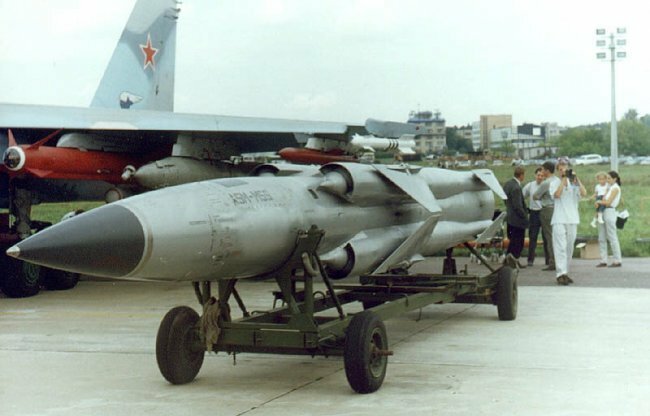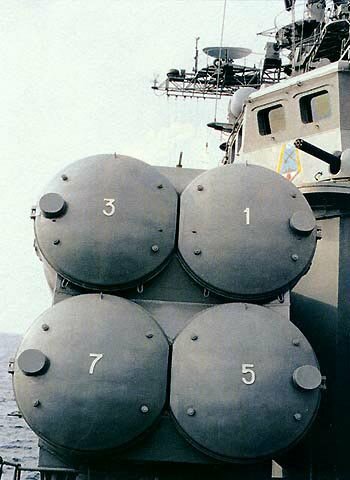Mosquito (SS-N-22, Sunburn, ASM-MSS), anti-ship missile system with a cruise missile 3М-80
Anti-ship cruise missile to destroy surface targets
History create
The anti-ship cruise missile (ASM) 3M-80 Mosquito, as the main element of the eponymous anti-ship missile system (SCRC), was developed by the GosMCB Raduga of A.Ya. Bereznyak (the city of Dubna, the general designer of IS Seleznev, commencement of work in 1973) in cooperation with other enterprises. The main elements of the rocket were developed: the onboard and shipboard control systems — Altair GNPO (Moscow, general designer S.A. Klimov); direct-flow rocket propulsion engine of the rocket - OKB-670 (Moscow, chief designer M.M. Bondaryuk) and the Soyuz Design Bureau (Turaev, Chief Designer VG Stepanov), the starting engine is KB-2, Plant No. XXUMX Minaviaprom (Moscow, Chief Designer I. Kartukov). The launcher of the complex was developed at the Mechanical Engineering Design Bureau (Moscow, chief designer N.K. Tsikunov).
The SCRK with the 3М-80 rocket Moskit was originally designed to replace the P-15 cruise missiles and was planned to be installed on destroyers, missile boats and ekranoplans.

Prior to the adoption of the Moskit rocket launcher, a large volume of tests was carried out, which began in June 1978 at the Sandy Beam training ground with two successful throw launches of a rocket model with a starting engine. After flight design tests of the Moskit complex, its state tests began, which lasted until the end of 1982. They ended on November 28.11.1982, 956, with multiple salvos of two missiles of one launcher from the destroyer pr.XNUMX Desperate in the Barents Sea in the North navy. At a range of 27 km at a ship speed of 20 knots, the target was hit by both missiles. During these tests, out of 15 launches, 8 were recognized successful, 5 partially successful and 2 unsuccessful. From 1983 to 1988. SCRC "Mosquito" was tested to improve the tactical and technical characteristics of the ZM-80 rocket (a flight range of 125 km was achieved), as well as to use it from the winged aircraft "Lun" pr.963.
The ZM-80 rocket and its modifications were mass-produced by the Progress software (now OJSC Arsenyevskaya Aviation Company "Progress" them. N.I. Sazykina, Arseniev, Primorsky Territory).
The complex was repeatedly demonstrated at air shows in Chile, Abu Dhabi (United Arab Emirates) and in Zhukovsky near Moscow (MAKS).
At the beginning of the 80-ies, the Moskit SCRC with the 3М80 rocket was adopted for destroyers of the type “Sovremennaya” pr. 956, and in 1984, with the 3М-80Е rocket in two quadruple KT-190. Aviation option SCRC "Moskit" was adopted for the period 1992-1994.

appointment
The Moskit anti-ship missile system with a cruise missile of type 3М-80 is designed to destroy surface ships and transports from ship-borne attack groups, amphibious formations, convoys and single ships (displacing, hydrofoil, airbag) up to 20000 tons. travel up to 100 nodes in fire and electronic countermeasures of the enemy in difficult weather and climate conditions at ambient temperatures from –25 to + 50 degrees. C, rough seas up to 6 points (up to 5 on small targets) and wind speed from any direction at sea level to 20 m / s. Resistant to the effects of a nuclear explosion.
Aviation version of the air-to-ship missile 3-80 can be used on deck-mounted aircraft such as the Su-33 (Su-27K) and is designed to destroy enemy ships.
Composition
The structure of the SCRK "Mosquito" includes: anti-ship, supersonic, low-altitude, self-guided cruise missile of type ZM-80, ship control system 3Ц-80, hated launcher KT-152М, complex ground equipment KNO 3XXXX
Features
The supersonic self-guided anti-ship missile 3М-80 "Mosquito" belongs to the class of light anti-ship missiles and is designed according to the normal aerodynamic configuration. The rocket fuselage is a body of rotation with an ogival shape of the nose and an X-shaped arrangement of folding wings and tail. On the body there are four side air intakes with air ducts, the front fairing has a radiotransfer. In the manufacture of the fuselage used titanium, steel and fiberglass.
The rocket is equipped with a combined (sustained-through ramjet 3D83 engine with a built-in starting powder accelerator) propulsion system. The accelerator is placed in the nozzle of the main engine, after 3-4 seconds after the start it burns and is pushed out of the nozzle by the oncoming air flow.
Targeting is carried out by a combined (inertial navigation system with an active-passive radar homing head) control system, which ensures a high probability of hitting the target during enemy radio resistance. For the purposes of the type of group of boats and ship strike group, it reaches 0,99, convoys and troop compound - 0,94.
The flight of the anti-ship missile at a speed of more than 2М carries out a complex trajectory - after starting it makes a “slide”, then decreases and continues flying at an altitude of about 20 m, and 9 km before the target makes an anti-aircraft maneuver - decreases to 7 m above the crest of waves and flies trajectory "snake". During the flight, the anti-ship missile can make intensive anti-aircraft maneuvers with overloads of more than 10 units. The defeat of the target occurs by breaking through its hull due to the large kinetic energy and the explosion inside the ship. This ensures the sinking of the target up to the cruiser, and the 15-17 missiles are capable of destroying the ship group. It is almost impossible to avoid the anti-ship missile defense "Moskit", since it is found 3-4 seconds before the meeting with the aim and, according to domestic and foreign experts, it is the best anti-ship missile in the world.
Location and condition
The Moskit PKRK with the 3М-80 PKR was installed: on destroyers pr.956 (2 quadruple PU type KT-190), large anti-submarine ships pr.11556 "Admiral Lobov", on more than 20 missile boats pr.1241.9. (2 paired PU KTM-152M on each side), on an experienced small rocket ship (MRK) pr.1239 on an air cushion of a skeg type (2 quad PU), on an experienced MRK-5 pr.1240 on underwater wings (2 paired PU ), on the "Lun" ekranoplane, can be used in parts of the coastal defense and in naval aviation - on a Su-27K (Su-33) shipboard aircraft one missile can be positioned under the fuselage between the nacelles.

According to the Resolution of the USSR Council of Ministers (from 4.01.1981, No. 17-5), the complex was upgraded in order to increase the firing range by improving the characteristics of the cruise engine. 10 test launches RCC "Moskit-M" held in the period 1987-1989. from the boat pr.1241.1. The maximum range of 153 km was reached, and the modified RCC was designated 3М-80Е.
At present, the Moskit SCRC is allowed for export both as part of Russian missile boats Ave 12421 and destroyers Ave 956, and separately for placement on the ships of the customer.




Information